- What is your daily need for the items in your bag?
- Most items are directly related to my job or facilitate my ability to do my job the way I like. Others are just-in-case sorts of items. And then there are items that have accumulated and are not needed, which speaks to my personality a bit.
- How might these items be considered “texts” and what do they say about you, the places you inhabit, the cultures with which you engage, and/or the activities you take up?
- The computer symbolizes that I have privilege and financial resources to purchase such a machine, and the fact that I use it for work speaks to the type of teaching I do, with multimedia elements. It’s important to me that I have the computing power and capability to do what I like, rather than being restricted by the technology my workplace might provide. The lack of food or other survival equipment shows that I inhabit a non-wild space.
- Thinking about the title of the course, what are the “text technologies” in your bag, if any? What do these items say about how you engage with language and communication?
- The student work is being marked, and written feedback is in the process of being provided to my students. I communicate to them both the level to which I think they are demonstrated the learning I’ve expected and how they might improve. The business cards have a sociocultural weight to them, and communicate contact information for financial services provided by my wife’s office. She doesn’t work on commission so it’s less about referral business for business’s sake and more about offering people help if I encounter such a situation. The lack of paper based day planner or notebook also says something about how I operate – I rely on technological text based tools and technologies to keep my life and work organized and I embrace those affordances over paper based technology.
- What do the items in your bag say about the literacies you have?
- the computer and adaptor show some digital literacies, and an ability to operate in different spaces with different technologies; I am somewhat of an early adopter but want to remain functional in legacy spaces with my colleagues and the resources available at my workplace. On the surface, the pens imply I’m able to write. At a deeper level, the green pens represent emotional literacy, as in the potential psychological effect on students of work marked in red pen that I’ve been made aware of. I also possess literacies of holding responsibility and conducting myself in my job; the keys give me access to most of the spaces in my workplace (school) but that doesn’t mean I have the right to access or ought to access every space those keys might allow.
- How does the narrative of the (private) contents of your bag compare with the narrative produced by image you have of yourself or the image you outwardly project?
- The fact that I keep my work keys in my work bag while all my other effects like car keys and wallet are kept in a drawer in my house speaks to a strong aspect of my personality in that I am forgetful and keeping work things together is a coping strategy. I outwardly project an organized person, but I have to communicate that this is a developing skill and a coping strategy. I also dress fairly well in brands people might recognize, but people often aren’t aware that most of those clothes were purchased at a deep discount when I was working a retail job before I had full time work teaching. Said another way, I don’t like to spend money but that isn’t how I appear, and my free leather bag is no exception.
- What would this same bag have looked like, say, 15 or 25 years ago?
- In terms of technological advancement, decades ago this bag would contain either a larger laptop computer or no computer at all. Likely more paper (my own teaching materials as well as students). In terms of my own life and development, decades ago this bag would be far less organized and inconsistent day-to-day.
- How do you imagine an archeologist aiming to understand this temporal period might view the contents of your bag many years in the future?
- An amazing question and hard to answer. I don’t know if an archaeologist would be able to predict my job as a high school teacher from the contents of the bag alone. They would be able to place the time period based on the technology of the computer and the dongle. The reusable mask might narrow it down to the 2020 pandemic so long as there aren’t more pandemics to come!!!
Task 2 (2.3) – Does Language Shape the Way We Think?
Activity 1.4 – Defining Terms
What do the words “text” and “technology” mean to you?
Part 1. What is text? What is technology? How would you define these terms? (initial thoughts without consulting resources).
Text, as I use the term over the last few years, refers to a collection of characters that represent meaning. In my case it is usually Canadian English. In this way, my schema for information or language can be words, actions, thoughts, or text. I tend to add the suffix “book” when referring to a textbook, and find the word text referring to an entire book to be a bit old fashioned or stuffy – something nose-in-the-air academics say. It’s also a buzzword in pedagogy circles, when they refer to “different texts.”
I also use text as a verb meaning to send a message to someone through imessage or mms/sms. It’s quirky, but I don’t refer to WhatsApp or Facebook messages as texts, and definitely not email.
I think of Technology as referring to a tool created by an organism. Nothing created by a natural process counts as a technology, but any thing created by an organism that has a function does, whether it’s a crow using a stick to collect food, or a human made machine that can detect cancer. Additionally, technology usually constitutes an invention that makes some process easier, better, or accomplishes something new. I would consider the ability for ancient humans to produce pigments and create lasting cave art to be technology, but the art itself is not.
I recently listened to Ursula Frankin’s 1989 Massey Lecture on technology, in which she expanded the definition to include processes and systems as well – an individual artisan’s process would not constitute technology, but a formalized systematised process such as one that would be performed on an assembly line or to mass produce something (as opposed to art) constitutes technology. To me, this still fits my definition; even though there is no physical object to point at and call technological, the rote process is a human creation that can be taught and achieves a useful end.
Part 2. Words that might have been updated based on technological advancements.
Drive
Memory
Screen
Web
Phone!
Tab
Window
Cookies
Part 3. Notes from OED Definitions
I find it interesting that my own initial definition was correct, but that my assumption about the older and more recent usage was inverted: text as referring to words is the older and original meaning, while text as short for textbook is newer (1993 addition).
It was fascinating to learn that technology originally meant a treatise on art, but the first excerpt emphasizes that it is particularly human creation as opposed to words attributed to divine origin. Also interesting is that the word technology referred to subject terminology or “technical words” in the 1600s before actually coming to mean mechanical applied science in the 1700s. It makes perfect sense that it evolved in such a way.
Part 4. Ngrams
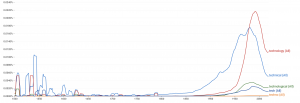
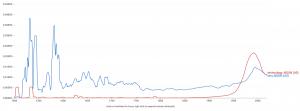
I can’t help but wonder if a large factor in the early use of “text” is due to errors in OCR and early pre-modern English script. I don’t see any patterns that seem enlightening. The word text has had consistent use while technology was comparatively unused until a recent surge. I tried breaking down different words with “tech” as their root and it was interesting that technical had been in use far earlier, presumably with the rise of industry.
Part 5. Conclusions
I think there’s a poetic beauty to text meaning woven, or the tissue of a literary work. It really paints a picture of the meaning of the words being greater than the sum of the characters that comprises them. Teche as in teaching is related to technology in the sense that technology is a human creation of applied science, and those processes can be conveyed to a learner.
IP #6 – Prescriptive and Holistic Educational Technologies, and the Magic of Audio
Topic 6: Prescriptive vs Holistic Technologies
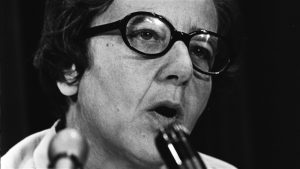
“It is my view that today’s real world of technology is planned and run on the basis of a production model that is no longer appropriate for the tasks we want to undertake. Any critique or assessment of the real world of technology should therefore involve serious questioning of the underlying structures of our models, and through them, of our thoughts”.(Franklin,p.26)
Prescriptive and Holistic Educational Technologies
and the Magic of Audio
by Christopher Spanis
Based on:
Ursula Franklin (1989) The Real World of Technology, part 1
Ursula Franklin (1989) The Real World of Technology. House of Anansi Press
Illich, ABC: The Alphabetization of the Popular Mind, ch 2
What is it like listening in to this lecture from 30 years ago in this elite educational setting? Describe the kind of “media ecology” this lecture created. In what ways is the formal lecture an “educational technology”?
Franklin delivered her lecture in what was then still a male dominated world. Her arguments of inherent maleness of technologies and professions and gender inaccessibility necessitated by it reverberate through the room. Thinking of the lecture itself as an educational technology, Franklin’s definition of technology as practice and system (more than artifacts), and her insistence that we ask not “what” but “how,” Franklin’s Massey lecture is a powerful unpacking of assumptions and structures we (and the audience) take for granted. In this way it reminded me of McLuhan’s “the media is the message.”
The lecture opened up, for me at least, media ecology to the point that everything is in play; “technology has built the house in which we all live,” as Franklin states in her opening. We shape and inescapably are shaped by the world, and the near infinite complexity and inter-and-intra-connectedness of its components and its inhabitants make up this whole media ecosystem. It’s an intimidating thought. It explodes the concept of context – that nothing can be understood in a vacuum, but as a science-minded individual I have to think that it doesn’t mean we can’t still try to understand everything.
Lecture, as a method of the conveyance of ideas, can be thought of as an educational technology. It is different from conversation, obviously, in that the communication is unidirectional. Ideas are not being co-constructed. The audience does have a role in the lecture, I hypothesize, in a similar way as the phenomenon of social laughter: people laugh more often and more heartily when with others than when alone. The shared experience of watching and listening to a lecture may have a unique effect on the brain compared to other media. Lecture is subtly different from an essay or writing in that the presence of the author or speaker changes the dynamic of criticism, as de Castell and Luke (1983) say of Olson: that students don’t have, or don’t feel they have, the right to criticize text until they belong as members of “the club” at a certain level of authorship. So too lecture audiences may take more care in formulating their criticisms due to social pressures, and the additional option of access to the speaker/author after the lecture is unique to the modality.
How do Franklin’s categories of “prescriptive” and “holistic” technologies from The Real World of Technology apply to educational technologies?
Holistic technologies, in an educational context, would include the practice of teachers with autonomy to “control the process of their own work [and] make situational decisions as the work proceeds,” as Franklin says. The interpretation of curriculum, activities, instructional and assessment methods, and all of the media forms utilized would be under the umbrella of holistic technologies. Prescriptive educational technologies would include, as “designs for compliance” or “specialization by process,” the curriculum itself, institutionally mandated texts, and trainers (as opposed to teachers).
Illich and Sanders’ ABC: How is the ‘memory palace’ a peculiarly “oral” technology?
As a student of biopsychology in my undergraduate studies, I have been aware of the memory palace for some time. I like the idea of the mind palace as a technology, as in a thing that is useful to a purpose, a tool. It is a way of remembering that I’ve never managed to get to work, though to be fair my past efforts were not particularly strong. It is peculiarly oral because it is unnecessary to use with writing, as, especially with computer word processing technology, writing can be paused, checked, and edited. Its effectiveness (and impressiveness) is most apparent in the oral context. I’m aware of people with uncanny mental mathematical calculating abilities who claim to use the memory palace technique; these “stunts” are impressive because they are done without writing, typing, or mechanised calculation – any representation of data or thought process outside of one’s self.
Indeed, Illich’s thesis is upheld by modern neuroscience. Functional magnetic resonance imaging gives us a window into the functioning of the brain, and it seems that memory is reconstructed each time it is recalled. This is why eyewitness testimony is to be distrusted in court. The success of the algorithms by which we reconstruct events give us the illusion of recall, of “bringing that past into the present.”
What differences did you see as you switched from listening to skimming to close reading? Were you able to experience the recorded lecture in any ways differently than when reading the text? Listening takes more “real world” time, so where did spending that extra time get you in terms of understanding? What things did you notice?
Skimming is a technique I find often used in a particular context – that of confirmation. I find I tend to skim only when I already have made my mind up about what the writing is about, and my eyes flick across the page hunting for some useful nugget to pull out as an exemplar to support my confirmation bias.
I absolutely experienced the oral format differently than reading – As a fan of CBC Ideas, the Massey Lectures, podcasts, and a lover of audiobooks myself, I find special value in the format. With no hard evidence to support my claim beyond my own subjective experience and introspective reporting, I can tell you some things about listening:
- I can listen while doing other menial things, like highway driving, household chores (e.g. dish washing, lawn mowing, laundry folding). This makes listening preferable to reading.
- I can allow my mind to wander while listening, often visualizing, daydreaming, or I daresay hallucinating the content of the audio as a movie in my head or stare blankly into space as schemata in my schema filing cabinet are re-filed and shuffled about. My listening takes place in the theatre of my own mind palace. There is a risk that I may be distracted by something external or internal and I will miss something, but often it is no trouble to replay the audio from a known point.
- The speaker gives an inimitable human touch that provides verbal context and assists comprehension and meaning making through intonational relevance-tagging. Everyone has experienced the phenomenon of reading to the end of a passage and having not the faintest idea what was read and having to go back and read it again. When listening, I have the benefit of the tone of the speaker’s voice rising and falling, conveying the relevant terms or anchoring each sentence.
- I find I am less likely to misunderstand a sentence when listening as opposed to reading. I have less time to formulate an argument or criticism while the audio continues, but the human connection (voice) seems to spur that part of my brain on, where with reading I may have as much time as I like to stop and think of arguments, only to find upon continuing the passage or rereading that my argument is either misguided or null due to a misreading.
- Sometimes I can get impatient with listening, as it is occurring in real time. Technology allows us to change the playback speed on some platforms, and indeed I have often played nonfiction videos at 1.5x speed to expedite the information transfer.
Conclusion
Suzanne, I want to thank you for a thought-provoking journey. COVID notwithstanding, I found this course the most challenging yet, and I believe I underestimated the investment required to do well and to learn as much as possible. This course really was so interesting and deserved a better version of me at a better time. Most of all, I really feel the absence of the live interaction of a face-to-face class. The content so much to chew on and it would have been so much better in person with colleagues and you.
When I started this MET journey I did so with the intention of learning and developing my abilities to use technology effectively in my f2f teaching practice, while much of the MET course content has been thematic on distance/online learning. If COVID has taught me anything, it is that for all the innovations in online learning thus far, it still does not hold a candle to in-person INTRAaction. I wish that I had dived more deeply and chew on more of the materials you prepared and plan to do so when other things settle down a bit. I sincerely hope to have a chance to work with you face-to-face. Thanks for your patience and support. The final project presentations made for an impressive and fun evening.
Regards,
Chris Spanis
image credit: https://www.lemoyeu.fr/massey-lectures-the-real-world-of-technology-cbc/
@LeytonSchnell:
Educationalist and advocate for the non-normative learner
A “Twittering Task” by Christopher Spanis
For Dr. S. de Castell
UBC ETEC 565B
Disclaimer
First of all, I have to declare that I am not a twitter user. I, for some reason, find the platform frustrating and several attempts to “get on Twitter” due to professional “encouragement” have fizzled out. That said, I acknowledge the massive power and influence of this social medium(a) and the following is my attempt (from ignorance, as a novice) at an unbiased analysis of education, pedagogy, educational theory, philosophy, and practice; innovated, shared, discussed, and appreciated.
The Someone:
Public Twitter feed: @LaytonSchnell
Dr. Leyton Schnellert, UBC. Education researcher, Associate Professor in the Faculty of Education, and Eleanor Rix Professor of Rural Teacher Education.
What are they Talking About?
Leyton’s primary topics include rural education, teacher training, literacy, and supporting both teachers and diverse learners. His posts almost always convey gratitude, pride in others, acknowledgement, humility, reconciliation, and openness. I truly admire him and am honoured to know him.
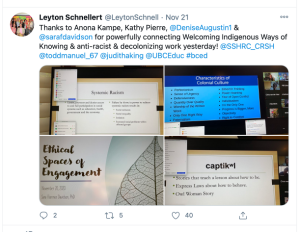
Rural Education
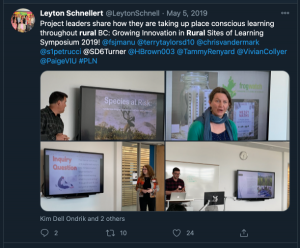
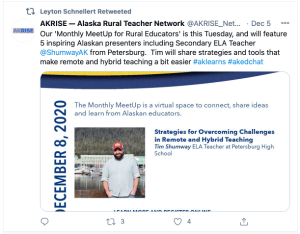
So interesting that investments in access and opportunity for remote learners would pay dividends to urban students come a global pandemic. Leyton has been an advocate and researcher for supporting rural education in BC (and beyond) through technology and pedagogy, in the top example, place-based learning.
Teacher training (middle years focus)
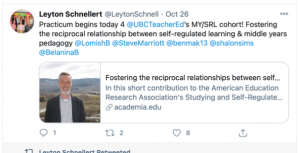
Leyton is an enthusiastic educational mentor and passionately promotes the injection of the honest self into one’s practice. This post on the intraconnectedness of pedagogy and self-regulated learning speaks to his own educational theoretical foundation of the importance of students developing metacognition, and the reflective and diffractive practices of teachers-in-training.
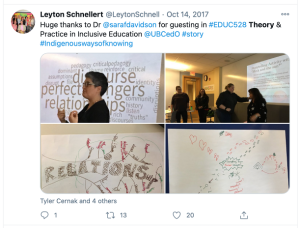
Another gracious post highlighting the ideas, work, and time shared by an educationalist in the Okanagan indigenous tradition. When Leyton pays his guests such honour and gratitude visibly to his students and colleagues, it subconsciously reinforces the notion that indigenous ways of knowing, and integrating them into teaching practice, are valuable and necessary. This as opposed to a tokenistic mention out of obligation as has been the case historically.

Literacy
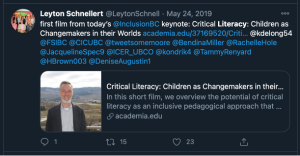
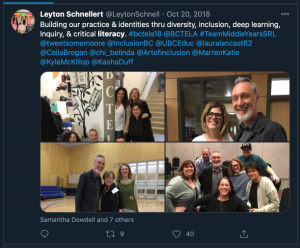
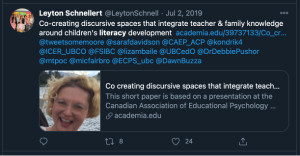
Leyton wrote extensively on literacy, namely reading and writing, for middle years in the 2000’s. In the last decade he has expanded his literacy work to include self-direction and criticism blended into inclusive education. This represents a refreshing departure from literacy as the “three R’s” as was discussed previously (e.g. de Castell and Luke).
Supporting Teachers, Supporting Diverse Learners
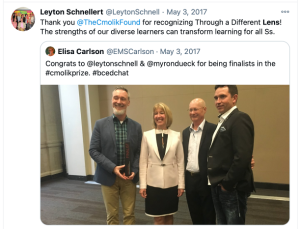
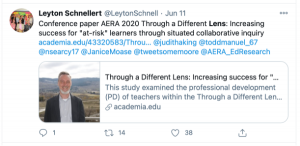
Leyton’s career and Twitter presence places special emphasis on diverse learners – marginalized, impoverished, dropout risk, kids who don’t fit in or for whom the traditional classroom model doesn’t work. He has been recognized for this work, and it represents a pedagogical shift from the grading standards of the twentieth century, and yet the notion of equal access to education harkens back to Dewey.
“Could curriculum, not should curriculum.”

This hashtag is meant to emphasize a transition in British Columbia over, at least, the past five years from a curriculum comprised of a specific “checklist” of prescribed learning outcomes (or P.L.O.’s) to one with centred on competencies with suggested content. I think this is meant to be liberating for teachers’ practice in that teachers are not only freer to cover topics of interest to themselves and the students, but also to not rush and teach at a pace that is suited to the children dynamically. However, I do also flinch when I read this hashtag as I think it presents a slippery slope, as we are finding evidence in my world of secondary academic subjects that students are coming in from elementary school with progressively weaker and weaker science, math, and reading literacy skills. I have no evidence that elementary teachers are not doing their jobs – surely other highly relevant literacies are being emphasised, but if the hashtag is taken to grant some teachers permission to omit entire fields of study important to students’ literacy, life-critical skills and abilities, then I am not on board.
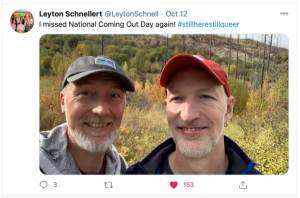
This one doesn’t speak directly to educational theory or pedagogy, but it is not entirely disconnected. I think it’s very important that Leyton, as a homosexual male, is open about so much of himself on a public stage. This is valuable for students, parents, teachers, and the general public to see: Leyton doesn’t just preach inclusivity, he lives it.
Who Are they talking about?
Leyton is a big fan of Shelley Moore and mentions her frequently. Some highlights of Leyton’s retweets include promoting leaders in inclusive education, teaching literacy and mathematics through gamification, SOGI events (sexual orientation and gender identity, an inclusive catch-all alternative to LGBTQ2S+), co-constructed curriculum, mentorship, and strategies on the timing of assessments in the learning process (not rushing to writing, building a knowledge base).
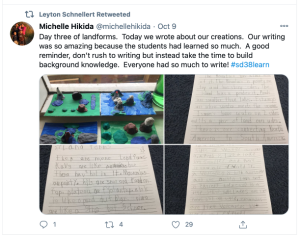
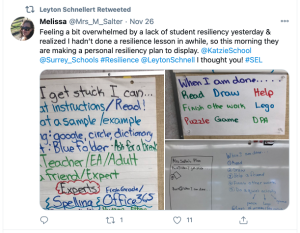
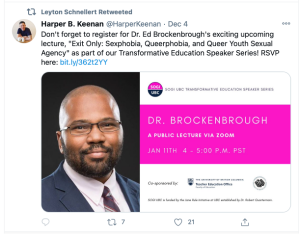
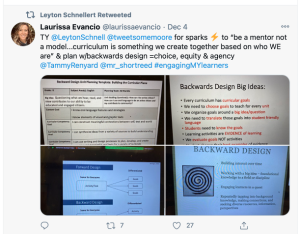
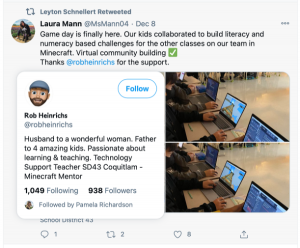
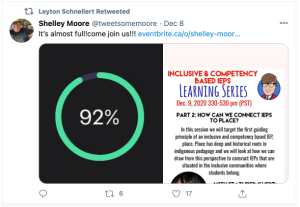
How and why does that matter to education?
Leyton has carved out an important position redefining what teachers traditionally take for granted. His account is very active, showcasing his work ethic and passion for changing the approach teachers take with students who have difficulty in schools from a deficit-based perspective to one of inclusivity. Leyton shows himself to be an advocate of strong educational theories and philosophies while not giving the air of an ivory tower academic. He is a boots on the ground, ear to the people educationalist.
How is Twitter reshaping “educational theory?”
In a positive way, Twitter has given teachers, parents, and students access to ideas that they otherwise would have been geographically, temporally, socioeconomically, or academically (as an exclusive community) isolated from. If we ignore for the moment the filtering algorithm of the Twitter feed, Twitter gives people access to people and ideas that they would have had no control over through other served-and-consumed media, such as television or radio (as in, one watches what’s on, rather than searching and watching on-demand).
So Twitter has changed the delivery method and accessibility of educational theory, that much is obvious, but has it also changed the content? That I am unsure of. Perhaps the speed with which ideas can and are being shared affects the evolution and criticism of ideas. Perhaps there is also an effect on the implementation of new practices, as seeing posts from theorists and other practitioners might make teachers more likely to try new practices compared to the traditional way of reading about them in research journals.
In a negative way, the bite-sized format of tweets and the architecture of a Twitter feed may contribute to a shallow internalization of content. Meaning: users read the headline and move on, either not getting the true meaning, perhaps getting the meaning but not receiving the nuance and complexity of a given topic/issue, or simply taking all feed items as truth and not parsing for validity. This is also problematic for attribution; users can post others’ ideas as their own and the tweet will be subsequently shared, misquoted, misinterpreted.
Personally, I have never taken to Twitter. I find I prefer longer narratives with more detail, which I can skim or ponder. I find tweets lack context or nuance due to the character limit, and the user interface makes it difficult to follow discourse, which may be by design or may be my ignorance and limited understanding of the platform. Leyton uses twitter as I would imagine doing (and briefly did), using it as a place to share links to work and the work of others. He tends not to tweet/post philosophy or pedagogy in sound bites. This is a great example of his research and professional work on accessibility – Twitter is an efficient way to reach people with links and to be reached and shared with, but critical educational conversations do not seem to be happening on Twitter. Or, if they are, they are not easy to find and follow. Twitter may be great for dissemination of theory but may not be the ideal platform for discourse of theory. …But it is the one we seem to have found ourselves on.
IP#10 – Revisit and Diffraction of Educational Tool with New Materialist Perspective
This is my 10th and final intellectual production for ETEC 565B Metatheory and for it I’ve chosen to revisit my second production, originally an analysis of a desk as an educational tool or thing using McLuhan’s tetrad and Latour’s things. Now I revisit, reflect, and diffract on my work with a developing understanding of the new materialist perspective.
IP#3 – Tools and Technologies in Context: Paradigms of John Dewey
| Classical | Progressive | Dewey | Technocratic | |
| Philosophy | Education as the bedrock of democracy, and the attainment of requisite functional and societally relevant literacies. Democracy is the ideal system of governance and democratic society can only be attained and be stable through an educated populace. “Educated” defined as the ability to participate, communicate, and hold to account between citizens, politicians, and experts. This is a progressive philosophical ethical argument, but it is also a utilitarian, but perhaps not quite technocratic, view on education and/or literacy in that there does not seem to be an intrinsic hierarchical value system of literacy, only a threshold or minimum.
Empiricism, scientific method is the most reliable way of knowing. |
|||
| Psychology | “The mind as unfolding organism, social theory of mind (organism/environment transaction).” (deCastell and Luke, 1983).
Strong, fundamental acknowledgement of the human (and brain) as a growing and developing organism, and learning (becoming societally literate) as a key aspect of the growth and development. |
|||
| Sociology | Capital “D” Democracy | |||
| Conception of Literacy | the ability to function adeptly in society and to contribute to moving society forward. Communication and criticism skills for deep meaningful participation in democracy (participation meant to the fullest multifaceted extent, not just voting once every four years as some would use the term). Pragmatic executive and socially useful knowledge and skills beyond memorization and recitation. | |||
| Attitude to Education | Literally the most important institution in Western society. Should be available to all. In this way, Dewey is both Progressive and Technocratic, as education has both social significance and instrumental value. | |||
| Curriculum | Civics. Content and competencies: “content” texts in accessible language embedded with/within material of unique and particular interest to each student and student-writing in their common tongue. Competencies are both individually useful and socially relevant. | |||
| Pedagogy | Instruction should be evidence based. Children (their brains) develop naturally and classroom activities should follow suit, with activities appropriate to abilities, provide opportunities, and foster continuing growth. | |||
| Evaluation | Important to assess both knowledge and skills/competencies. | |||
| Outcome | Socialization and successful integration into society as an adept participant.
Dewey completely informed and reformed the current educational system, though sometimes more in spirit than in practice. For example, instructional strategies or methods can follow the ebb and flow of fads without the evidence-based scientific rigour that Dewey would have demanded of methods being practiced or scrapped. |
Dewey was without doubt a progressive. That much is painfully obvious. But I don’t think he was necessarily anti-technocratic; his firm belief in democracy as the highest ideal and public education as the pillar of democracy leads one necessarily to the conclusion that Dewey operated in a technocratic paradigm of literacy as not only self-expression and social interaction but also as requisite set of functional skills and knowledge for the success and survival of each individual/citizen and the greater society. Each individual must meet a minimum level of competence to be a participant. Where Dewey really departs from technocratic educational philosophy is in the curriculum aspect, as in decontextualization of skills; Dewey was antithetical to this through his revolutionary insistence on socially relevant, personalized contextual curriculum with value in the injection of the individual.
I think that, in terms of educational knowledge or curriculum, to be an adept (as I keep using the term) member and participant in society, civics literacy is not enough. Our world has changed so much technologically since Dewey’s time, and the technological change has permeated and infiltrated so much of our lives, consciousness, and identities that digital literacy and arguably STEM in general deserve to share that top spot on the curricular podium. Few imagined, (unless you were a reader of Asimov, Sagan, Orwell, etc.) that unlimited access to an interconnected network would lead to a commoditization of attention and would be used as a tool for mass disinformation. As a science teacher, while my colleagues and I find ourselves in an educational landscape more and more favouring social and pragmatic competencies over content, my thinking is that scientific knowledge, and knowledge of the history of scientific discovery up to now have instrumental value; I like to think of it as “catching students up” on “stuff they should know,” as in, “what does humanity know about how the universe and everything in it work and how have we come to know?” This by extension leads students to imagine – and strive to build the skills (and support others in society to build the skills through social and political processes) for – “how will we figure the rest out?”
Final Project and Diffraction
For the Final Project I worked with Scott Richmond. We produced a video with research-backed tips to help parents help their own children with math homework. We realized that this was an activity that many educational institutions are asking of parents, and that may cause conflict for many parents and students, especially with homeschooling during the COVID-19 lockdown. Here is the video and our reflection on its production:
- In terms of design, the primary desire was something more than a “talking head” video in addition to being more engaging than text or audio alone. We also strongly followed a design principle of being accessible and easily digestible by non-academic audiences, or a non-educators, so a citation-laden paper was out of the question, and even our original design idea of a “tip sheet” for parents seemed inadequate for our primary goal in these regards.
As for motivation informed by educational researchers of the past, we propose that part of the anxiety surrounding parents’ lack of mathematics confidence and/or competence (for which we found strong evidence in the literature) may be rooted, ultimately, in a deficit of literacy; one operates in society as an adult and parent with the assumption (possibly false, but necessary as a defence mechanism) that one is operating as a literate member of their culture, which includes a functional mathematical ability. This, paired with an unconscious fear that one’s child may also lack this literacy facet and requisite, would naturally cause radical insecurity. In this regard, we took this to be a bigger issue than simply the concerns over children and their math grades as the research may suggest, and this was informed by our reading of DeCastell and Luke (1983) in terms of, not only academics, but also societal values and power. - In terms of assets, the sound effects and titles were taken from the catalogue of available options in iMovie, but all of the illustrations and voiceover work was one hundred percent generated by the two of us. Scott and Chris collaborated on the idea and script over the phone. Chris brought in the initial papers which supported the starting idea, Scott did a larger portion of the supporting research. Scott also did a majority of the illustrations and some of the voiceover, and Chris did a majority of the voiceover and video editing. This paper was co-written.
- While Chris had some experience with video editing, he had never attempted stop-motion or RSA style videos involving sped-up footage to match the length of the audio for the particular effect. Scott had to develop the skills of camera setup and framing, requiring multiple takes to accomplish his vision for each segment. Of note, we both also built this video project from the research forward, as opposed to setting out to do a video with a particular agenda and finding research to support pre-conceived arguments. This was new to both of us, as often in undergraduate and other studies, students may start with a thesis and select research to fit. In this case, we examined the literature, filtered with theoretical perspectives and pragmatism, and build the video guide on what we determined to be most helpful.
- The purpose of our tool was to help parents and the medium had to be equally as accessible as the message. The use of whiteboards was partly based on the format itself being a popular fad for informational videos, and on its ease of production for the two of us; no complicated animations or programming were required.
- While we did not place particular emphasis on identity representation… nor did we explicitly target any particular group for engagement, we attempted, with our limited time and resources (and talent) to not reference any particular ethnicities or genders with our illustrations, nor, in fact, did we ever represent more than one parent at a time with a child, thereby avoiding unintentional viewer interpretations of family structure or makeup. We definitely fall short in accessibility for non-English speakers or the hearing impaired – Chris intended to supply subtitles for the video but did not have time (also, to be fair, the video is a proof-of-concept and not a polished market-ready product).
Both of us are actually somewhat surprised to have created something that we would share with our students’ families. Our final product has a sincerity, pragmatism, authenticity, and lack of agenda that neither of us expected to come out of this project. As for an “aha! moment,” we both agree that it was in the moment when we realized the conflict that existed and is created by the educational institutions and structures asking parents to be involved and the chaotic possibilities and realities of what that actually looks like at home. We realized this juxtaposition created a niche in which our tool could exist, be a viable solution, and could be produced in a simple and interesting way.
IP #2: The School Desk – An Educational “Thing”? or Something More? (and Why)
IP #1: Media Ecology – definition and what it means for education
An Introduction to the Concept of “Media Ecology”
Strate and Lum’s (2000) article was a biography of a founding media ecologist, but they don’t make clear their definition without looking at the authors’ other works. Reading Lum (2000), it seems that media ecology has to do with communications technologies, how they – and their use – have evolved over time, and how they tend to serve larger constructs like the capitalist political and war “machines.” Different interpretations seem to exist and their validity an ongoing argument, but my main takeaway is that communications technologies (CTs) do not and can not exist outside of culture, and the interaction between CTs and culture is bidirectional.
As I see media ecology, we are looking at a system of at least four components: humans, tools, the physical and virtual structures we create (with those tools), and communication. Viewing the interactions between these four from a biological paradigm we can talk about them as an ecosystem because the parts don’t interact with one another independently of their context – there is an interaction with the context as well: We develop and have these technologies; we use them, they interact, evolve, are changed, fail or persist; and they influence us.
Now, in terms of what I think an educational media ecology would have to involve, I should start with my attempt at a distillation of what Education is and should be:
- “Stuff you should know”
- “Learning how to think”
By “stuff you should know,” I mean a critical role of education in the life of the individual (student) is essentially to get everyone “up to speed” as a human in society; how did we get here, why are things the way they are, and what do we know?
By “learning how to think,” I mean the other key role of education in a liberal democratic society is to afford every individual with the competencies and skills to be successfully adaptable in the future; ought things be the way they are, what is the role of inquiry and criticism, and what are the open, unanswered questions?
<<Updated 04 Oct. 2020>> Finally, I’ll attempt to address what facets and complexities an educational media ecology has to encompass, but I feel like I won’t be able to adequately address the question until the end of this course. Here is a beginning of an attempt based on what I know now:
First, a clarification: “media ecology” is the study of media analogous to an ecosystem, just as “ecology” is itself the branch of biology which studies “the relations of organisms to one another and to their physical surroundings” (Apple Dictionary). An educational media ecology (EME) would therefor specialize in the examination and study of the media, user interactions, and context (environment) of educational settings. EME would, for example, investigate (and potentially attempt to prove hypotheses surrounding) the presence of, and/or influence of hegemony, inequity, echo chambers, or the intrusion of intolerance in educational media ecosystems. EME would also look at whether a media ecosystem is growing in a progressive or maladaptive direction (for users); as another example, the reconciliation movement in Canada doesn’t have the “answers” to right wrongs, it exists to encourage acknowledgement and dialogue, which are steps in the direction of progress. EME would examine this dialogue AND the infrastructure facilitating the dialogue, and their influence on one another. EME evaluates whether there is equity of access, freedom of expression, and moderation to protect the infringement of the rights of others.
In the field of EME, as with any scientific field of study, it is important to be aware of, and prevent, bias. Therefore peer-review and self-criticism are crucial. However, there is validity to different perspectives within EME as a field of study, just as there are two schools of thought within media ecology itself (i.e. the North American and European “schools”). As an example: it can be viewed in media ecology that there is always a struggle or tension between “man versus the machine” (Strate & Lum, 2000). EME would study educational ecosystems from a perspective of teaching and raising children/students/users as critical consumers and thoughtful producers with strong digital literacy – are the students mastering technology to improve the benefits of a useful tool, or are they learning to become masters because they must, because technology is insidious and unavoidable?
References:
Lum, C. M. K. (2000). Introduction: The intellectual roots of media ecology. New Jersey Journal of Communication: The Intellectual Roots of Media Ecology, 8(1), 1-7. doi:10.1080/15456870009367375
Strate, L., & Lum, C. M. K. (2000). Lewis mumford and the ecology of technics. New Jersey Journal of Communication: The Intellectual Roots of Media Ecology, 8(1), 56-78. doi:10.1080/15456870009367379